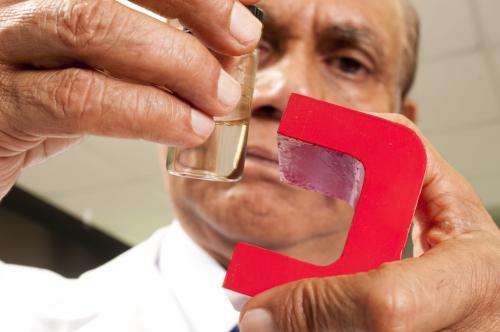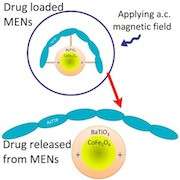New nanotechnique to deliver life-saving drugs to the brain

(Phys.org) —In a study published in today's issue of Nature Communications, researchers from FIU's Herbert Wertheim College of Medicine describe a revolutionary technique they have developed that can deliver and fully release the anti-HIV drug AZTTP into the brain.
Madhavan Nair, professor and chair, and Sakhrat Khizroev, professor and vice chair of the HWCOM's Department of Immunology, used magneto-electric nanoparticles (MENs) to cross the blood-brain barrier and send a significantly increased level of AZTTP—up to 97 percent more —to HIV-infected cells.
For years, the blood-brain barrier has stumped scientists and doctors who work with neurological diseases. A natural filter that allows very few substances to pass through to the brain, the blood-brain barrier keeps most medicines from reaching the brain. Currently, more than 99 percent of the antiretroviral therapies used to treat HIV, such as AZTTP, are deposited in the liver, lungs and other organs before they reach the brain.
"This allows a virus, such as AIDS, to lurk unchecked," said Nair, an HIV/immunology researcher.

The patent-pending technique developed by FIU binds the drug to a MEN inserted into a monocyte/macrophage cell, which is then injected into the body and drawn to the brain. Once it has reached the brain, a low energy electrical current triggers a release of the drug, which is then guided to its target with magnetoelectricity. In lab experiments, nearly all of the therapy reached its intended target. It will soon enter the next phase of testing.
Potentially, this method of delivery could help other patients who suffer from neurological diseases such as Alzheimer's, Parkinson's, epilepsy, muscular dystrophy, meningitis and chronic pain. It could also be applicable to diseases such as cancer.
"We see this as a multifunctional therapy," said Khizroev, who is an electrical engineer and physicist by training.
Multi-disciplinary efforts that combine principles of those fields with immunology enabled the project to move forward.
"The success of our nanotechnology is derived from the fact that nature likes simplicity," Khizroev said.
More information: www.nature.com/ncomms/journal/ … full/ncomms2717.html
Journal information: Nature Communications
Provided by Florida International University

















